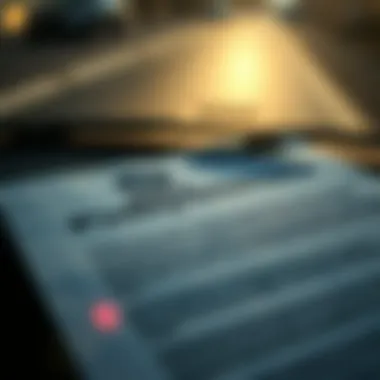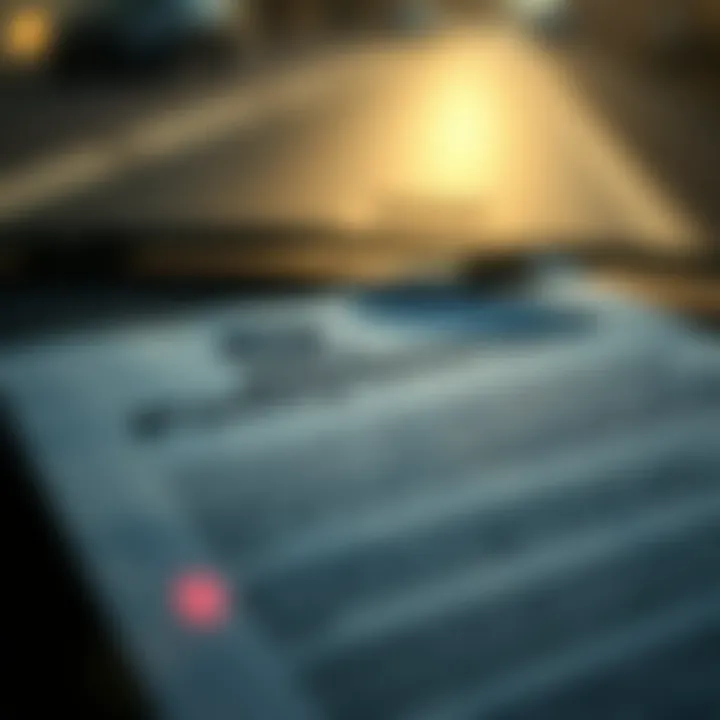How to Effectively Cancel Dealer Gap Insurance


Intro
When you drive off that dealership lot, you might feel like you've just struck gold. The car of your dreams, a shiny new key fob in your pocket, and a hefty contract stapled neatly in your glovebox. But somewhere buried in those fine print pages is something that could leave you feeling less than triumphant: dealer-provided gap insurance. It's crucial to understand what you’ve signed up for and how to navigate the often perplexing waters of canceling this added expense. This article aims to shed light on the path to canceling dealer-provided gap insurance, weaving through your rights, the financial ramifications, and answering common questions along the way.
Understanding Financial Literacy
Definition and Importance
At its core, financial literacy refers to the ability to understand and use various financial skills effectively, including budgeting, investing, and, yes, managing insurance products. When it comes to gap insurance—an add-on often touted by dealers to cover the gap between what you owe on a car and what it’s worth—being financially literate is the key to making informed decisions. It empowers you to not only discern the necessity of such insurance but also to evaluate if your hard-earned cash is better spent elsewhere.
Basics of Financial Literacy
Grasping the basics of financial literacy involves recognizing common terminologies and practices. For instance, how do deductibles work? When would you need comprehensive coverage versus liability? Such knowledge is foundational and helps avoid pitfalls. Understanding the ins and outs of contracts and agreements is also paramount, especially when deciding whether to keep or cancel a service like gap insurance. Knowing your rights and obligations typically leads to better financial outcomes.
"Being informed is your best defense against unnecessary expenses."
Importance of Budgeting
Overview of Budgeting
Budgeting is more than just a buzzword; it’s a systematic approach to managing your money. It involves tracking income, expenses, and ensuring you allocate funds to build savings while minimizing debt. When considering gap insurance, creating a budget can help reveal if this additional cost fits your financial landscape. If it doesn’t, knowing how to cancel it without stress is crucial.
Benefits of Having a Budget
The benefits of budgeting stretch like a well-planned road trip—it provides direction and minimizes last-minute detours that can lead to financial trouble. Among these benefits is the clear visibility of where your money is going. A budget enables you to prioritize needs versus wants, ensuring that, for instance, the premium for gap insurance doesn’t choke your budget.
- Clarity: You’ll see exactly how much you’re spending on insurance.
- Control: It helps avoid impulsive purchases that could lead to buyer's remorse.
- Goals: It aids in setting financial goals like saving for that new car or for vacations.
Arming yourself with financial knowledge and budgeting skills will not only help you navigate gap insurance cancellation but will also enhance your overall financial health. As we proceed through this guide, you’ll find practical steps to approach the often complicated task of removing dealer-provided gap insurance from your repertoire.
Understanding Gap Insurance
When it comes to buying a vehicle, understanding gap insurance can make all the difference. This type of insurance is specifically designed to bridge the financial gap between what you owe on your auto loan and the vehicle's actual cash value in the event of a total loss. It's an essential concept that many buyers need to grasp before purchasing a vehicle, especially for those who are financing their cars or leasing them.
Definition and Purpose
At its core, gap insurance covers the difference—or the gap—between your car's current market value and the remaining balance of your loan or lease. For instance, if you have a car worth $20,000 but still owe $25,000, gap insurance could help you cover that $5,000 difference if your car is declared a total loss following an accident or theft. This coverage essentially protects you from being left hanging with an unpaid loan after your car has already been taken from you.
In today's world, where car values can depreciate rapidly, gap insurance serves as a safety net, offering peace of mind against unexpected financial burdens. It’s particularly beneficial for individuals who have made a minimal down payment or those who are underwater on their loans.
Common Misconceptions
There are several misconceptions surrounding gap insurance that can muddle understanding and lead to poor financial decisions. Here are a few:
- Myth #1: Everyone Needs Gap Insurance
Not every driver needs it. If you purchased your car outright or have a substantial down payment, you may not need gap insurance because you wouldn’t owe more than the car's value. - Myth #2: It's the Same as Comprehensive Insurance
Gap insurance and comprehensive insurance are fundamentally different. While comprehensive covers damages to your car from non-collision-related incidents, gap insurance focuses solely on loans and their remaining balances. - Myth #3: Gap Insurance Can Be Cancelled Anytime
Many think they can just drop the coverage whenever they desire, but canceling it often involves specific procedures and timings that need to be followed.
"Understanding what gap insurance truly entails can help consumers make more informed decisions when purchasing auto policies, situating them well in financial discussions."
By brushing aside these myths, potential car buyers can better assess their needs and make sound financial decisions. Clarifying these points not only helps with understanding gap insurance but also equips individuals with the knowledge to navigate their financial obligations effectively.
Overall, a strong grasp of gap insurance clarifies its role in the vehicle ownership journey, shedding light on when it makes sense to opt for this additional coverage. It empowers buyers to make informed choices, ensuring they're not creating headaches for themselves down the road.
Reasons for Canceling Gap Insurance


Gap insurance can often feel like an umbrella that protects you from the storm of financial loss, especially if your vehicle is totaled and you owe more than it’s worth. But there comes a time when holding onto that financial safety net may no longer make sense. Understanding the reasons for canceling this coverage is crucial in making informed decisions about your insurance needs moving forward.
Initially, the question of whether to keep gap insurance hinges on your current financial situation and equity in the vehicle. As loan balances decrease or if you've made significant improvements in your vehicle’s worth, reconsidering the necessity for this insurance can save you money without leaving you exposed to significant risks. Let's take a deeper look into the specific reasons that might motivate you to cancel your gap insurance.
Reduction of Outstanding Loan Balance
As you make payments on your vehicle loan, the balance you owe gradually decreases. This reduction is particularly relevant if you opted for a loan with a short term or if you've made extra payments. The closer you get to owning your vehicle outright, the less critical gap insurance becomes. Since gap insurance primarily protects against financial loss in the event of a total loss, having a lower outstanding balance diminishes the associated risk.
If your loan balance is lower than your vehicle's current value, the need for gap coverage diminishes significantly. For instance, if you took out a $25,000 loan when your car was new, and after a couple of years, you owe $15,000 while the car is valued at $20,000, you don’t need the same level of protection as when you first started. If you're no longer "upside down" on your loan, that’s a green light to consider canceling your policy.
Improved Equity in the Vehicle
Equity in your vehicle represents the ownership stake you have in it. This insight is key when deliberating about your gap insurance. As equity increases—say, through consistent payments or if you’ve made enhancements to the vehicle—your financial vulnerability regarding loss diminishes substantially.
Let’s illustrate this with a simple example: you buy a car for $20,000. After three years, due to depreciation and repairs you've made, the car is now worth $12,000, but you've only paid down your loan to $18,000. Your gap insurance fills that $6,000 hole. However, if, through payments and maintenance, your car's value rises to $15,000 while you owe just $10,000, you’ve effectively gained $5,000 in equity. At this point, you’re no longer at a significant financial risk that warrants gap coverage.
Alternative Coverage Options
Lastly, let’s explore the potential for alternative coverage options. Sometimes people cling to gap insurance like a safety blanket, but other insurance products might better suit your current needs. Policies like comprehensive coverage or an “agreed value” policy can provide security against loss without the additional expenditure of gap insurance.
For instance, if you’re driven by peace of mind and also want broader protection against theft or fire, opting for comprehensive insurance with a slightly higher premium might be a better fit. Take the time to weigh your options; after all, the goal is to ensure you’re not paying for any double coverage you might not need.
Choosing to cancel your gap insurance should not be hasty. It’s essential to evaluate if you have a significant reduction in your loan balance, if your vehicle equity has improved, or if alternative coverage can suffice. Each of these factors can lend weight to the decision, empowering you to take charge of your financial future.
Evaluating Your Current Policy
Taking the time to evaluate your current gap insurance policy is crucial before making any hasty decisions about cancellation. Understanding the nuances of your policy can mean the difference between financial loss and a well-informed action. It’s not just about reading the fine print but getting to grips with what your policy covers, how it fits into your financial picture, and whether it still serves your needs.
Reviewing the Terms and Conditions
The first step in your evaluation should be a careful review of the terms and conditions of your gap insurance policy. This document is the blueprint of your coverage and contains critical information about what is and isn’t covered.
- Look for Exclusions: Many policies have exclusions that can lead to misunderstandings when you need to file a claim. For instance, if your vehicle is classified as a total loss, your claim may not cover everything you think it does. Understanding these nuances can prevent unwelcome surprises.
- Payment Terms: Are premiums fixed, or can they change? Knowing whether your costs could increase in the future helps you budget effectively.
- Cancellation Provisions: Check how you can cancel the policy and whether there are any penalties for doing so. A lack of clarity here can put you in a tough spot later on.
By being proactive and understanding these terms, you can better gauge whether keeping the policy is worthwhile or if exploring other options makes more sense.
Assessing Coverage and Costs
Next up, take a closer look at both the coverage provided by your gap insurance and the costs involved. This step is highly significant, particularly if your financial situation has changed since you initially purchased the policy.
- Coverage Adequacy: Ask yourself whether the coverage adequately protects you in your current financial scenario. For example, if your vehicle is worth significantly less than when you bought it, you might not need as much coverage anymore.
- Cost-Benefit Analysis: Compare the annual premiums with the potential payout of your policy. How does it stack up against your other expenses? If it feels like you’re throwing money down the drain, it’s time to reconsider.
- Options for Better Coverage: If your current premium feels steep, it might be worth exploring additional options. There could be better-designed insurance products out there that offer similar or better protection at a lower cost.
In sum, a comprehensive assessment of your coverage and costs doesn’t just clarify whether you should cancel. It also opens the door for finding alternatives that provide better value without sacrificing financial security.
"Understanding your policy is the first step in making an informed decision. Don’t let confusion hold you back from optimizing your insurance strategy."
Through careful evaluation, you empower yourself and pave the way for making decisions that best suit your lifestyle and financial objectives.
Steps to Cancel Gap Insurance
Navigating the cancellation of dealer-provided gap insurance can feel like a maze. Understanding the steps involved not only eases the process but ensures you make informed decisions. Knowing how to cancel gap insurance can save both time and money, especially when your situation changes. This section is designed to guide you through the necessary steps to effectively cancel your gap insurance policy, addressing key considerations and the benefits of a well-executed cancellation.
Contacting the Insurance Provider
The first step in canceling your gap insurance is reaching out to the insurance provider. This may seem straightforward, but it’s where many can stumble. You’ll want to gather some basic information before making that call. Have your policy number handy, and be prepared to explain your intention to cancel clearly.


Discussing your cancellation with a representative not only sets the wheels in motion but also provides an opportunity to ask any lingering questions. Perhaps you want to clarify any potential refunds or implications on your current vehicle insurance.
While on the phone, pay attention to the representative's guidance. Every insurance provider has its own protocols, and they may offer insights specific to your situation that you hadn't considered.
Gathering Necessary Documentation
Before submitting a cancellation request, ensuring you have the right documentation is crucial. This ensures a smooth and efficient process. Start off by collecting documents such as:
- Gap Insurance Policy Document: This outlines your coverage details.
- Payment Records: Proof of payments can be critical, particularly when discussing refunds.
- Vehicle Information: Identifying details about the car, including the VIN (Vehicle Identification Number).
Having all relevant documents at your fingertips helps in avoiding any lapses or misunderstandings during the cancellation process. A neatly organized file can simplify discussions with your insurance provider, making it less likely you'll miss anything important.
Submitting a Written Cancellation Request
Once you’ve contacted your provider and gathered your documents, the final step is to submit a formal cancellation request in writing. This request should ideally contain the following details:
- Your Name & Contact Information
- Policy Number
- A clear statement requesting cancellation of the gap insurance policy
- Reason for cancellation, if applicable
- Signature (or typed name if emailing)
It’s essential to send this letter via a method that provides proof of delivery. Consider using certified mail or request a delivery read receipt if emailing. This way, you have a tangible record of your request, which could prove valuable later on.
In closing, the steps to cancel gap insurance—contacting the provider, compiling necessary documents, and submitting a formal request—are foundational elements in freeing yourself from a policy that may no longer serve your financial interests. Addressing these steps with attention can smooth your path, leading to better financial decisions down the road.
Remember, transparency is key. If you're unsure about any part of the process, don’t hesitate to ask your insurance representative for clarification.
For additional information, you may consult resources from credible institutions like the National Association of Insurance Commissioners or visit educational sites like Investopedia for insight on navigating insurance-related matters.
Potential Financial Implications
When considering the cancellation of dealer-provided gap insurance, understanding the potential financial implications is crucial. This exploration not only encompasses the monetary aspects, such as possible refunds but also the interplay with other insurance policies.
Gap insurance provides coverage that fills the void between your vehicle's value and what you still owe on your loan in the event of a total loss. While this serves a specific purpose, the implications of canceling this coverage can catch many off guard. As you navigate this journey, recognizing how these financial aspects may impact your overall budgeting plays a vital role.
Refund of Premiums Paid
When you decide to cancel your gap insurance, one of the significant financial aspects is the potential refund of premiums paid.
If you've paid for the gap insurance upfront or have been making monthly payments, you might be eligible for a refund. However, understanding the pro-rata basis of these refunds is essential. Typically, the refund is calculated based on the time the policy was active versus its total duration.
For instance, if you bought a three-year policy and canceled it after one year, you might expect to receive two-thirds of your premium back. But don’t bank on it just yet; ensure you check the specific terms laid out in your policy.
Here’s a quick rundown of steps to consider regarding your potential refund:
- Review Your Policy: Understand the terms related to cancellations.
- Contact Your Provider: Speak with your insurance provider for detailed information.
- Keep Records: Document all communications regarding cancellation and refunds.
"Familiarity with your policy terms can save you a penny or two, or perhaps even more."
Effects on Other Insurance Policies
Cancelling gap insurance can also affect other aspects of your financial landscape, particularly in relation to your other insurance policies.
Many individuals aren’t aware that their car insurance and gap insurance can be interconnected. If gap insurance is bundled with other insurance products, like auto or home insurance, you should consider whether canceling it might trigger changes in those policies. Here are some implications:
- Risk Assessment: Without gap insurance, your car may be seen as higher risk, possibly leading to increased premiums elsewhere.
- Negotiating Bundles: If you carry multiple policies with the same insurer, you might lose leverage in negotiating your rates.
- Continuous Coverage Needs: Assess if you need another type of protection, such as a different form of collision insurance.
Essentially, the financial ramifications are not limited to just the gap insurance policy itself. They can ripple outwards, influencing your overall insurance expenditures. Keeping a tight lid on your budget means that every decision—even the cancellation of a single policy—deserves careful thought.


Avoiding Pitfalls During Cancellation
When the decision comes to cancel dealer-provided gap insurance, it is essential to tread carefully. The process might seem as straightforward as tearing off a Band-Aid, but small missteps can lead to headaches down the road. One miscalculation can leave you out of pocket, or worse, unable to recoup expenses associated with the policy that no longer serves your needs. Understanding the ins-and-outs of the cancellation landscape is vital to sidestepping potential traps. The insights below provide a deep dive into this facet of insurance management, equipping readers with the knowledge needed to navigate their cancellation journey smoothly.
Common Mistakes to Avoid
- Procrastination: Many car owners drag their feet when it comes to canceling an unused gap insurance policy. This inaction can lead to wasting money on premiums that could have been allocated elsewhere. It’s crucial to address this promptly to avoid mounting excess costs.
- Overlooking Required Documentation: Forgetting to gather necessary documents can bring the cancellation process to a grinding halt. Ensure you have details like your policy number, vehicle information, and any prior correspondence—all in one place before making that call.
- Failure to Understand Terms: Many policyholders enter cancellation discussions without a clear understanding of their policy's terms. This lack of preparation can lead to misunderstandings regarding refunds or other benefits.
- Ignoring Pre-existing Conditions: If you anticipate needing gap insurance again, ignoring policy terms about re-enrollment can complicate future purchases. Always consider your long-term plans regarding vehicle financing and coverage.
- Not Following Up: Cancelling a policy is just the beginning. A follow-up ensures that the cancellation request was processed correctly. Falling off the radar can lead to unexpected premiums continuing to be deducted.
Understanding Policy Cancellation Terms
Every gap insurance policy has specific cancellation terms that dictate how one can discontinue coverage. Being well-versed in these terms can save valued time and resources.
- Notice Period: Generally, policies may require a notice period before cancellation takes effect. Know how much time you must afford before your request is processed.
- Refund Provisions: Most gap insurance providers will offer a refund for any unused premium. Understanding how this mechanism works will clarify what you can expect when you cancel.
- Procedural Requirements: Each insurance company may have unique procedural requirements for cancellation, whether it’s needing written notice or specific forms to fill out. One can avoid unnecessary delays by familiarizing oneself with these aspects beforehand.
- Reinstatement Policies: Should you find yourself needing gap insurance down the line, knowing whether your insurance provider allows for re-enrollment and any penalties associated will help make more informed decisions in the future.
By steering clear of common mistakes and having a strong grasp of cancellation terms, you'll fortify your position in the process and minimize the risks involved. Always remember, knowledge is power, especially when it involves financial decisions that can impact your financial standing.
Frequently Asked Questions
In any financial journey, having questions is part and parcel of the process—especially when dealing with insurance. This section shines a light on common queries regarding gap insurance cancellation. By addressing frequently asked questions, we arm readers with the knowledge they need to navigate this often murky terrain. Clarity is key; understanding the nuances can lead to smarter decisions and potentially save you a pretty penny.
What if ’ve Already Filed a Claim?
Filing a claim while holding a gap insurance policy does complicate things slightly. Essentially, if a claim is currently under review or has already been settled, it might influence your cancellation process. In general, insurance providers tend to stick to their policies rigorously when it comes to ongoing claims. Thus, if you decide to cancel after filing a claim, you might not receive a refund for any unused premiums. It’s like trying to get your money back from a failed restaurant after finishing your meal—you had your chance, and now it’s too late.
Here are some key points to consider:
- Contact Your Provider Promptly: Speak to your insurance provider as soon as possible after filing a claim. They can help clarify your specific situation.
- Review Claim Status: Understanding whether your claim is still active or settled will help you navigate possible outcomes.
- Assess Your Financial Position: If the claim was significant, consider whether canceling the policy makes sense financially.
"It’s always a good idea to keep your insurance provider in the loop; they’re not psychic!"
Having clarity on these points can aid in making informed decisions moving forward.
Can Cancel Gap Insurance After Financing Ends?
When the dust settles, and your financing comes to an end, you may find yourself questioning the necessity of gap insurance. The answer here is yes, you can cancel your gap insurance after financing is complete. By then, you have likely built equity in your vehicle, minimizing or eliminating the risk that gap insurance is designed to cover.
However, keep in mind some factors:
- Timing Matters: Ensure your cancellation doesn’t overlap with any grace periods or deadlines concerning your existing agreements.
- Refund Policies: Depending on your provider, you might qualify for a refund of any unused premiums. It’s prudent to ask about this detail directly with them.
- Consider Future Needs: Just because financing has ended doesn’t mean you should jump ship immediately. Assess whether keeping the coverage aligns with your current financial situation and emotional well-being regarding potential vehicle loss.
In short, you can wave goodbye to gap insurance after financing, but it’s wise to weigh the pros and cons before making that final call.
The End
Cancelling dealer-provided gap insurance can seem daunting, but it doesn't have to be. Understanding the cancellation process is crucial not just for reclaiming funds but also for gaining control over one's financial responsibilities. In this article, we've highlighted the critical steps necessary to cancel your gap insurance, from contacting your insurance provider to understanding the terms and conditions that affect your policy.
Recap of the Cancellation Process
To wrap it up, let's get back to the nuts and bolts of canceling your gap insurance. The steps are usually straightforward:
- Contact the Insurance Provider: Begin by reaching out to your insurance company. This sets the wheels in motion and gets you in touch with a representative who can assist.
- Gather Necessary Documentation: Having your policy documents and identification ready will streamline the process. Check that you have everything needed before submitting your request.
- Submit a Written Cancellation Request: Formalize your request by sending a cancellation letter. Clear and concise writing will prevent back-and-forth and potential delays.
Always keep copies of your correspondence. This small but often overlooked detail can save you a headache down the line, should questions arise.
Empowering Continued Financial Literacy
Knowledge is the currency of empowerment, especially in today's fast-paced financial landscape. Understanding the nuances of gap insurance goes beyond mere cancellation. It's an ongoing educational journey. When you know what gap insurance entails and the pros and cons, you gain more than just peace of mind—you gain the ability to make informed decisions about your finances.
Reading materials, joining forums, and consulting professionals can deepen your understanding. Websites like Investopedia or resources from NerdWallet can offer valuable insights into car insurance and financial literacy.
Always make learning a habit; it pays dividends in the understanding of your assets, liabilities, and the intricate web of insurance policies. Remember, the more you know, the more you can navigate complex decisions with ease.



